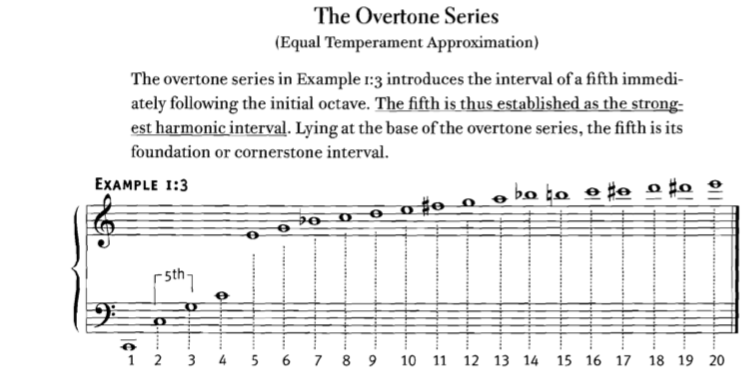THE LCC BY GEORGE RUSSEL: “Lydian chromatic concept of tonal gravity”.
If we look at the diagram below we see the “Overtone Series” The perfect octave and the perfect 5th. If you can think in terms of perfect 5ths then the LCC will be much easier to understand.
First we start with C Ionian [C Major in Classical western tradition].

Next George raises the 4th forming C Lydian [Raised 4th or#11]

Below we see Stacked 3rds in C major [Ionian] and then in C LYDIAN [Hence the f sharp at the top below the a note]
C ionian C Lydian [13TH]

Below we see George Russel’s TONAL GRAVITY of Stacked 5ths. Notice the flattened 5th in the first bar but the “Perfect 5th” in the second bar. [The second bar creating C Lydian].

Below is the piano layout which one can easily hear tonal gravity across the long span of the piano keyboard. We have the #11 [F#] to create stacked “PERFECT” 5THS” [which again results in C Lydian]

Below is a layout starting on the lowest F note in order to hear it all in full along the guitar fingerboard. There is also a version in the second bar that moves around with C as the tonic due to lack of span on the guitar fingerboard.

If we take the C major 7th chord and look at the C major scale we can see the “Avoid” note. The E note clashes with the F note and the B natural and the F natural produce a Dominant sound. By adding the Perfect fifth F# there isn’t any “Avoid” notes as displayed in the second bar below.

“The interval of a fifth is the building block of tonal gravity, a seven-tone scale created by successive fifths establishes the most vertically unified harmonic order whereby the gravity falls down each fifth back to the singular Lydian tonic”. “Andy Wasserman” F C G D A E B = ALL PERFECT 5THS = F LYDIAN
“The Lydian Chromatic Scale” The ANSWER TO ANYONE CONFUSED!
By stacking 5ths George Russel creates a chromatic scale but he skips the interval between the” Seventh and Eighth” notes,
WHY?
Because, using C as the Lydian tonic we get:
C, G, D, A, E, B, F♯,C♯, G♯, D♯(E♭), A♯(B♭), E♯(F), B♯(C) = a 12 tone scale
[Please play through those chords on a piano or guitar because it will make you understand the concept and what is to come in regards to the ingoing and outgoing of Tonal Gravity]

In the example diagram above we see George Russels “Tonal order” going from numbers 1 to 12. Numbers 1 to 7 being the Lydian mode.
When we go beyond the 7 notes of the lydian scale and further up the cycle of 5ths things increase in terms of dissonance.
George Russell terms the scales as”Ingoing” “Semi ingoing” “Semi outgoing” and “Outgoing” . The more we move to the right of the diagram the more “Outgoing/Dissonant” the scale will sound.
In terms of scale substitution we see a C# and not a D flat as this would be a raised 5th [Augmented 5th] and it would make no sense reading it enharmonically as a D flat as we see in the diagram above and in Georges scales.
GEORGE RUSSEL “VERTICAL” SCALES:
Basic Lydian [#11]

This could also be seen as 3rd mode of Melodic Minor

This could also be seen as 4th mode of the Harmonic Major

This could also be seen as the 4th mode of the Melodic Minor

This could also be seen as the Whole Tone Scale

This could also be seen as Octatonic Whole Half Diminished

This could also be seen as Octatonic Half Whole Diminished

As an “Afterthought” for any guitarists here is my fingering always leading with the 1st finger on George Russell “Vertical” scales.







LYDIAN PENTATONIC ASCENDING SCALE THROUGH THE CYCLE OF 5THS.
Finally, Horizontal Scales. Notice the B FLAT hence the Major.

Finding a parent scale,
From E Flat 7 going to A Flat major 7th we would employ the D Flat Lydian mode due to the G natural or #11 of the D FLAT LYDIAN to modulate to A flat major 7th.
PART 2 Final Analysis
The Lydian Chromatic Scale and best explanation from “Wikipedia”
Russell builds a prototype chromatic scale starting on the Lydian Tonic by stacking fifths, skipping the interval between the seventh and eighth tones. Using C as the Lydian Tonic yields the following 12-note scale with enharmonic respellings:
C, G, D, A, E, B, F♯,C♯, G♯, D♯(E♭), A♯(B♭), E♯(F), B♯(C). Thus the Lydian Chromatic Scale and all its derivatives contain only Pythagorean intervals.
OR
IN CONCLUSION It is a good idea to read George Russel’s most up to date book either from a reference library or purchase. It is a very expensive book to buy though so be warned. LINKS Wiki LCC lcc 
I HOPE THIS PAGE WAS OF USE TO YOU IF SO THEN PLEASE SUBSCRIBE TO US ON YOUTUBE BELOW, THANKS!



